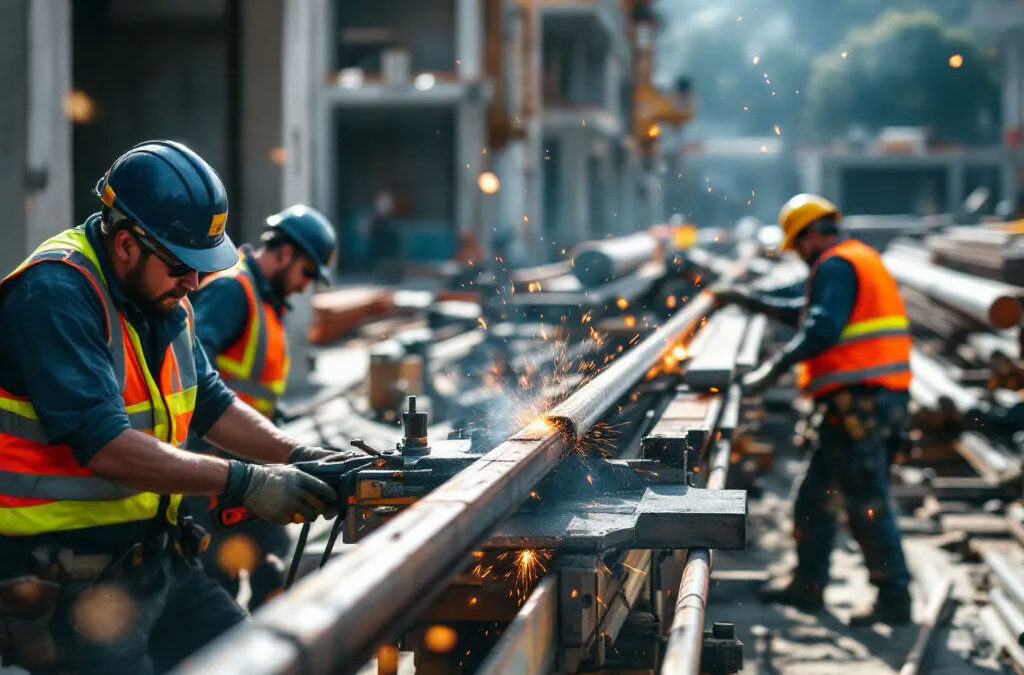Introduction
Reinforcing bar, commonly known as rebar, is a vital component in commercial concrete projects, providing strength and stability to structures. The efficiency and precision of cutting and bending rebar can significantly influence the success of these projects. Quality rebar cutters and benders not only enhance productivity but also ensure that the required specifications are met, minimizing the risk of errors during the construction process.
Understanding Rebar Cutters and Benders
What is Rebar Cutting?
Rebar cutting involves the precise severance of reinforcing steel bars to specific lengths necessary for a construction project. Effective rebar cutting ensures that the pieces fit seamlessly into the concrete framework, which is essential for structural integrity. Common types of cuts include straight cuts, angled cuts, and notches, each serving a unique purpose in the structural design.
What is Rebar Bending?
Rebar bending refers to shaping steel bars to conform to architectural designs and engineering requirements. The ability to bend rebar accurately is crucial to ensure that the bars fit perfectly within the concrete and achieve the necessary tensile strength. Common bending requirements often include standard 90-degree bends, loops, and stirrups, all of which are fundamental in creating reliable structures.
Importance of Quality Rebar Cutters and Benders
Investing in high-quality rebar cutters and benders can greatly impact overall project timelines and costs. Tools that perform poorly can lead to delays and increased labor costs, making it imperative to select reliable equipment. Precision and consistency in cutting and bending are critical; inaccuracies can result in structural weaknesses and additional expenses for rework. For additional cost-saving insights, see this guide on profitable bidding.
Types of Rebar Cutters
Manual Rebar Cutters
Manual rebar cutters are simple tools that require physical effort to operate. While they can be cost-effective and easy to use, their limitations include slower cutting speeds and physical strain on operators. However, they are ideal for smaller projects and locations where power sources are unavailable. They may also be practical in remote job sites impacted by weather conditions.
Hydraulic Rebar Cutters
Hydraulic rebar cutters leverage hydraulic pressure to make swift and precise cuts. These tools are effective for large projects or thick rebar, making them a favorite among commercial contractors. Recommended models, such as the Makita 4131, provide excellent power and ease of use, ensuring efficient operations on the job site.
Electric Rebar Cutters
Electric rebar cutters offer unmatched efficiency and speed, significantly enhancing productivity in commercial settings. These machines can make a clean cut in a matter of seconds, reducing labor time. When compared to manual and hydraulic options, electric cutters provide superior consistent performance with minimal physical exertion. Consider using key safety strategies for optimal results when deploying such tools.
Types of Rebar Benders
Manual Rebar Benders
Manual rebar benders are primarily used for smaller projects or to make adjustments on-site. They are lightweight and portable but lack the power needed for complex bends in thicker steel. Ideal for tightening bends on-site, they serve well in maintenance or repair tasks.
Hydraulic Rebar Benders
Hydraulic rebar benders are excellent for large-scale commercial projects, capable of making precise bends in substantial rebar sizes. These machines minimize operator fatigue and maximize productivity, ensuring each bend adheres to project specifications. Notable models, such as the Klutch 4-in-1 Rebar Bender, are often recommended for their reliability and performance.
Electric Rebar Benders
Electric rebar benders enhance efficiency by providing consistent results with minimal effort required from operators. They are particularly beneficial in fast-paced environments where accuracy is imperative. Operators should follow best practices, such as training on equipment use, to maximize safety and efficiency when working with electric benders. Ensure your team follows a pre-pour checklist for smooth operations.
Key Features to Consider
Cutting and Bending Capacity
The cutting and bending capacity of tools are paramount when selecting equipment for commercial applications. A tool’s power rating and maximum rebar size dictate its suitability for demanding tasks. Professionals should evaluate the specific rebar grades and diameters they will work with to ensure compatibility.
Portability and Weight
Portability is critical, especially on construction sites with varied terrains. Lightweight models enhance maneuverability, allowing for efficient handling of tools when moving between different locations. Selecting a tool that balances portability with robust construction can lead to significant efficiency gains in operational workflows.
Durability and Build Quality
The durability and build quality of rebar cutters and benders are vital for withstanding the rigors of commercial use. High-quality materials, such as hardened steel and reinforced frames, ensure longevity and reliability. Investing in well-constructed tools minimizes downtime and maximizes return on investment. Learn more about key differences in structural demands with this overview of commercial concrete jobs.
Safety Features
Safety measures are essential when selecting rebar tools to protect operators from potential hazards. Key safety features such as automatic shut-off, protective guards, and ergonomic designs should be prioritized to ensure user safety. A strong focus on safety not only protects workers but also reduces liability for contractors.
Top Rebar Cutters and Benders for Commercial Use
Comparison Chart
A comparison chart of top rebar cutters and benders offers an overview of models, specifications, pricing, and features. This provides a quick reference for contractors looking to make informed choices based on their specific needs.
In-Depth Reviews
Each recommended model will undergo thorough reviews, highlighting pros and cons relevant to commercial applications. User testimonials and ratings provide valuable insights, contributing to a comprehensive understanding of each tool’s performance in real-world scenarios. For more on project optimization, check out the top mistakes to avoid in commercial concrete construction.
Maintenance and Best Practices
Regular Maintenance Tips
Proper maintenance is essential for extending the life of rebar cutters and benders. Regular cleaning, lubrication, and inspections should be part of the standard maintenance routine to keep tools in optimal working condition. Proactive care prevents costly repairs and ensures consistent output. You may also benefit from understanding concrete curing times to optimize your schedule.
Safety Tips When Using Cutters and Benders
To ensure user safety, operators should adhere to best practices, such as wearing personal protective equipment (PPE) and undergoing training for specific tools. Ensuring a clutter-free workspace and following safety guidelines reduce the risk of accidents significantly. Recognizing equipment limitations and following the manufacturers’ instructions enhances safety during use.
Conclusion
Investing in high-quality rebar cutters and benders significantly affects the efficiency and precision of commercial concrete projects. Selecting the right tools can lead not only to streamlined operations but also to safer worksites and superior project outcomes. For contractors, choosing the ideal rebar cutter and bender involves assessing durability, performance, and safety features tailored to specific project requirements, setting the stage for successful construction endeavors.
Need expert help or a quote for your next commercial concrete project? Call us today at (916) 562-2345 and speak with us.


